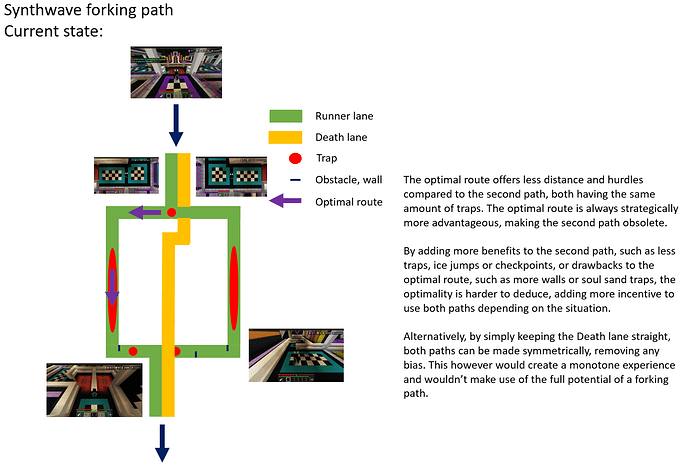Introduction
Synthwave introduces the runner to a new layout configuration, a forking lane.
After crossing the penultimate checkpoint, the player is presented with 2 possible lanes, a right one and a left one, based from the runners perspective. Both lanes have 2 turns and lead into a series of trap infested straights before converging again. On the first playthrough, they seem to follow a symmetrical pattern, however, this all changes when heading into turn 2.
The right lane will turn left and directly present the player with a newly added automated TNT-trap, after which the junction occurs. This will then lead to the final sprint.
The left lane will turn right and instead present a long straight, with Western-like barriers, forcing the runner to dodge them (if no leap available) and compromise the ideal running line. After that, analogously to the right path, an automated TNT-trap follows, after which the aforementioned junction occurs.
The issue
This descrepancy adds an obvious advantage to the right lane, making it simply more optimal in all regards. Thus, the left lane becomes obsolete, removing the duality of the forking path. Even accounting for the Death’ s lane and the playability of a Death player during this section, I don’t see a valid reason for such an unbalanced layout. Therefore, I’m asking for an explanation. Maybe there are elements I haven’t considered during my observation. I’d gladly take everything back and reconsider my position.
Simplification and considerations
To simplify the problem at hand, a pareto optimality has already been present numerous times in DR maps, e. g. the first Viaduct turn, where the shortest ‘paths’ used red, risky platforms, while the longest green, safe ones. This makes the discernment of optimal ‘paths’ more difficult, situational and fun!
A forking lane is a perfect playground for such events. By adding various elements that help or hinder a runner while keeping the average time it takes to run the individual lanes not too dissimilar, the choice between left and right becomes strategically relevant and longterm interesting. Viaduct’s first turn does it perfectly, Synthwave’s forking lane not so much.
To clarify the meaning of averge time in the context, it’s not about the relative distance needed to cover, it’s the runner’s average speed considering the different obstacles that might slow them down or speed them up. Distance, from an abstract view, can slow them down, but so can soul-sand traps, slimeblock jumps, ladders, parkour platform sequences and many more. Ice, speed pads, shorter distances, etc. can increase their speed. The element of risk, such as a trap, adds a chance of being slown down drastically because of the imminent setback, thus the average speed decreases.
Conclusion
I view this section as a missed opportunity and want to express how it could be improved in future maps, turning it from a weakness into a strength. I hope this post was coherent and helpful. I have linked a very rushed sketch to better visualize and highlight the issue. Thank you very kindly for reading!
I am not demanding any changes to the current layout, but I’d welcome one for sure and would love to contribute to suggestions ![]()
